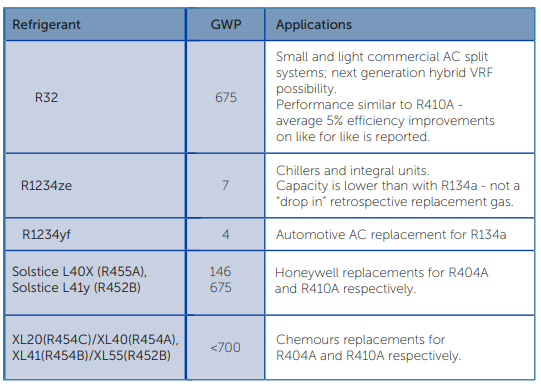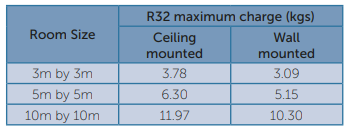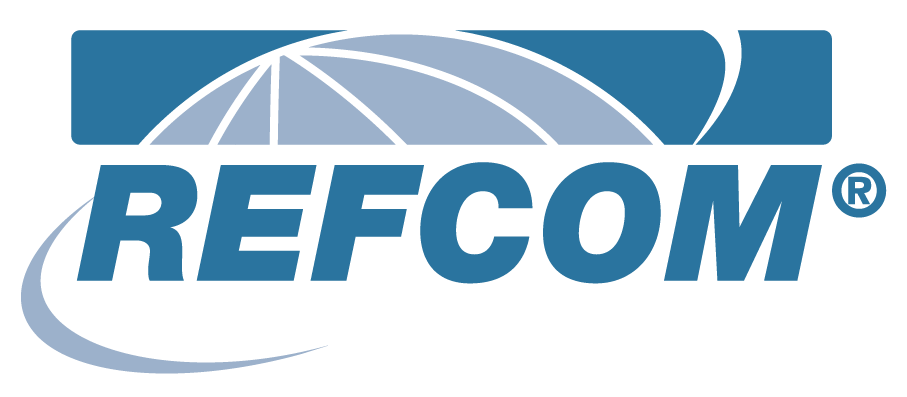Working with Lower Flammability Refrigerants
Advice and guidance on the change to working practices
We want to make sure that our REFCOM members are fully up to date on the changes to working practices needed when working with the new generation of A2L refrigerants. These replace the higher GWP HFC gases that are currently the industry norm.
A2L is a new safety classification from ASHRAE denoting lower flammability, sometimes referred to as “mildly flammable”. They generally have a much lower GWP (Global Warming Potential) than current common HFC gases.
Background

The fluorinated greenhouse gases regulation (EC517/2014), commonly referred to as the F-Gas Regulation, has introduced a phasedown of high GWP gases by limiting the amount of gas that can be placed on the market – that limit being expressed in terms of CO2 tonnes equivalent. The table above gives an overview of the current A2L alternatives in use or under discussion with an indication of what sector of the market they are applied to. The downside to lowering the GWP of a gas tends to be the increasing of flammability levels or other safety related issues. Many of the replacements for current standard HFCs are mildly flammable and have resulted in the new ASHRAE classification A2L – meaning that the gas is flammable but of a lower flammability level than a class 2 gas. In particular the lower flammability tend to be hard to ignite, and have a slow burning velocity of ≤ 10 cm/s under test conditions. As such, they are considered to be safe for use in approved systems and can be considered safe for general handling with certain provisos.
Best Practice
Installation
As long as standard, good installation practice is observed, there should be no additional risks involved.
”RAC80 Design Specification for DX Air Conditioning & Heat Pump Equipment” should be referred to, as well as our Technical Bulletin TB012: Jointing Methods which describe best practice to be observed while brazing copper pipes together. The use of the inert OFN2 when brazing not only prevents oxidization of the internal surface of the copper, it also displaces any residual refrigerant gas that may be in the pipework. In the case of an installation this should not be an issue, however best practice will guard against any inadvertent release of gas via a faulty or weeping stop valve allowing flammable gas to enter the pipe under test.
Service, maintenance and repair work
This is where more care needs to be taken when working with A2L systems. Please refer to our Technical Bulletins TB016: Safe de-brazing and TB023: Refrigerant Recovery for more information.
In particular, when recovering any A2L gas it is essential that a recovery machine marked as being suitable for A2L gases is used. Although the gases are rated “lower flammability” by ASHRAE standards, and are hard to ignite as we have discussed, they remain rated “flammable” under H&SE DSEAR3 and the ADR4 transport regulations guidelines for the UK. As such they are subject to more intrusive work planning and method requirements as well as for storing and transportation of the gas in bottles. Storage and transportation requirements are in line with what is required currently with acetylene and MAPP gas bottles.
Similarly, it is essential that only leak detectors and other electrical and electronic equipment that is rated as safe for use with A2L refrigerants are used where A2L gases are present. It is essential when attending a site for any repair work, or for routine servicing, that the technician ensures they are aware of what gas is in the system and treats the system as they would for a flammable gas, even if the system label does not state that a flammable gas has been used. As the availability of A2Ls becomes wider and the use more common, there is a chance that an A2L may be used even where it has not been identified.
TB016 highlights the dangers of de-brazing pipe joints and components without using an inert gas such as OFN. The inert gas not only prevents oxidization of the internal surface of the copper, it also purges any residual gas embedded in the refrigerant oil that will boil off when heated, creating a pressure rise that can be ejected at high pressure as the weld is melted. This can cause the oil and/or the gas to be ignited as they leave the joint being debrazed causing injury to operatives and/or equipment.
Planning – EN378 and Risk Assessment Method Statements (RAMS)
A number of additional considerations need to be taken when dealing with an installation or work involving an A2L refrigerant due to the H&SE DSEAR non recognition of A2L as a safety classification.
In particular, for a new installation, there needs to be a risk assessment carried out which reviews the application, refrigerant charge, location of components, and occupancy of any room containing refrigerant holding components. BSEN378 -2016: “Refrigerating Systems and heat pumps - Safety and environmental requirements” contains design information crucial to this risk assessment and management process and should always be referred to in the planning stage of an A2L installation. The standard is used for calculating the maximum permissible refrigerant charge in a system based on both toxicity and flammability. Whereas the earlier version of EN378 was fairly straight forward in dealing with flammable or non-flammable, there is now a more complicated design methodology to go through to calculate what maximum charge can be applied to a system if an A2L is used.

The table above is a basic rule of thumb calculation based on an R32 ceiling or wall mounted system showing the maximum charge that can be applied in the system, including where only the refrigerant containing pipework passes through the area, if installed in an openly accessible area. Note that floor mounted, window, wall and ceiling mounted systems have different multiplying factors and the figures in the table will be different for other styles of indoor unit. The maximum charge permissible in the case of the larger room has been capped at 11.97kgs for the ceiling mounted system after calculating the various methodologies applicable and taking into account the capped amount of 11.97 rather than the calculated 12.6 kgs. Whereas with the wall mounted system the maximum permissible charge for that room calculates to 10.3 kgs – lower than the capped value, so the calculated amount applies.
More detail of this methodology can be found in the full Technical Bulletin TB/033 which can be downloaded here.
It includes 'Practical Advice on using A1 and A2L refrigerants in Air Conditioning, Heat Pump and Refrigeration applications using EN378:2016' reproduced by kind permission of FETA6.
This capped amount of charge is currently limiting the use of R32 to split systems as no VRF/VRV is able to work with such a small total charge at the moment. Some manufacturers are currently looking at options for using A2L refrigerants in VRF for the future including developing “hybrid” systems that incorporate low GWP HFCs in a primary flow circuit limited to the multi control box heat exchanger, with the branches to indoor units being served by water circuits for heating or cooling thereby removing the actual refrigerant from the occupied space and removing the barriers to use under EN378.
For service work there also needs to be a full risk assessment carried out. RAMS produced for any work involving an A2L should include specific reference to the nature of the gas involved and additional measures being carried out to reduce any risks involved in the work.
Lower flammability A2L refrigerants should never be retrofitted into a standard HFC system without full safety risk assessment being considered and the full extent of EN378 taken into account. Installations which may pass the requirements of EN378 for R410A, for example, will very possibly not meet the requirements for R32.
F-GAS
- TB/046v2 F-Gas Product Prohibitions
- TB / 050 - F-Gas Quotas Who needs to hold quota for refrigerant?
- Technical Bulletin TB049 V2
- Refrigerants banned from use as of 1 January 2020
- F-Gas service ban and product prohibitions
- HFC Phasedown
- Leak Checking: Direct or Indirect methods
- Delivery of F-Gases
- Safe de-brazing in the RACHP sector
- Competence requirements for the RACHP sector
NOT YET A FULL MEMBER?
For a full access to a range of member only guides, downloads, support and benefits sign up now...
Find a Refcom Member
Search for members of both Refcom schemes by postcode or company name.
Read MoreApply for Refcom Certification
Applying for your company F gas certificate is a straightforward online process.
Read MoreLatest News
Mass SKILLcard rollout is boost for key professions
Thousands of fire sprinkler, local exhaust ventilation (LEV) and commissioning professionals are...
Read More
